Heckler and Koch MP5 A4/A5
It is very hard to write a review about a weapon
as well known as the MP5. Most users of this site will know something of its
history and use in modern times. This review does not seek to give the whole
story, but focuses in on one particular MP5 variant, the A4/A5. Brief references
are made to the history and development of the MP5, but far more information can
be gained through use of the resource section at the end of the review.
'It dominates. Heckler & Koch's MP5 submachine gun is the undisputed choice of the vast majority of law enforcement Special Response Teams and military Spec Ops units throughout the non-communist world. It has been so for almost two decades.'
© SoF Magazine
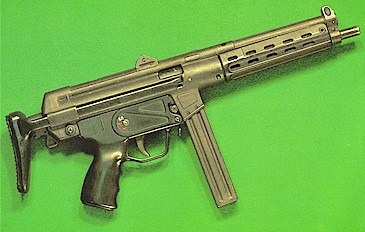 The
MP5 began life in the early 1960's as the HK54 through a project known as
'Project 64'. This early gun had a flip-type rear sight positioned forward over the magazine well. The barrel had cooling ribs and two lateral slots cut over the muzzle to serve as a compensator. The forearm had cooling slots cut into it,
the bolt carrier was longer and heavier than current models and the ejection
port smaller. Even at the early stage, the familiar SEF trigger group was an
integral part of the design. See picture right and below.
The
MP5 began life in the early 1960's as the HK54 through a project known as
'Project 64'. This early gun had a flip-type rear sight positioned forward over the magazine well. The barrel had cooling ribs and two lateral slots cut over the muzzle to serve as a compensator. The forearm had cooling slots cut into it,
the bolt carrier was longer and heavier than current models and the ejection
port smaller. Even at the early stage, the familiar SEF trigger group was an
integral part of the design. See picture right and below.
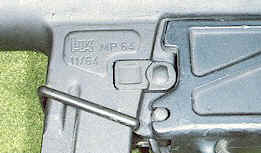
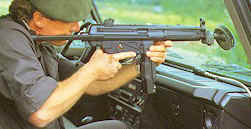 By 1966 the Heckler & Koch submachine gun had emerged
much as we know it today and was renamed the MP5. The muzzle brake and cooling ribs were eliminated and
three external lugs were placed near the muzzle, to accommodate a blank firing device, flash hider and grenade launchers of both the ballistite and bullet trap types. The rear sight was relocated to the
rear portion of the receiver and became the rotary-aperture type associated with the H&K system in general.
Shown right, an early HK MP5 A3 with slimline forearm and straight mags (being
aimed through a vehicle firing port).
By 1966 the Heckler & Koch submachine gun had emerged
much as we know it today and was renamed the MP5. The muzzle brake and cooling ribs were eliminated and
three external lugs were placed near the muzzle, to accommodate a blank firing device, flash hider and grenade launchers of both the ballistite and bullet trap types. The rear sight was relocated to the
rear portion of the receiver and became the rotary-aperture type associated with the H&K system in general.
Shown right, an early HK MP5 A3 with slimline forearm and straight mags (being
aimed through a vehicle firing port).
As most site users will know, HK weapons systems
of this era use a delayed blowback system of operation. If you really want to
know exactly how this works please see the links to HKPro below. Suffice to say
that blowback is delayed via a roller/locking system in the bolt/carrier and
between the recesses in the barrel extension (in the receiver of the gun). The
system is complex, but effective and reliable (despite the fact that the bolt
assembly is more complex than many other SMG). The MP5 fires from a closed bolt,
i.e. ignition of the cartridge is not as the bolt slams forward (open-bolt
type), but rather is achieved via a hammer falling against a firing pin
(obviously when the trigger is pulled and after the initial cocking operation).
This makes the MP5 an extremely accurate weapon.
The MP5 A4/A5 was first produced in 1982. In
fact, versions were produced before this date, but the trigger group was marked
with an S, E, 3F and F rather than the pictogram style markings used now. For
those who don't know, the MP5 series of weapons are classified through the use
of an A, K, SD, or PDW letter code. Additional codes including N and PT are also
used. The first MP5s were classified A2 and A3; the ''2' representing a fixed
and the '3' a folding/sliding stock MP5 with a three-position trigger group (SEF
or safe, semi-auto and burst fire). The A4/A5 differs from the A2/A3 only
through the addition of a four-position trigger group; safe, semi-auto, 3 round
burst and fully automatic (burst) fire. To my knowledge very few MP5 A4/A5 have
been deactivated and therefore the review weapon shown below is very rare.
The weapon itself is a pre-95 deac. It was
deactivated by Falcon Gun Co. and has been cut quite sympathetically apart from
the fact that the actual bolt has been removed (i.e. the roller assembly rather
than the bolt carrier). This is quite common in HK deacs. If you are really
lucky, you might find an example with a fully strippable bolt assembly (usually
cut by Helston Gunsmiths or Manton Arms), or occasionally the whole bolt is
there, but has been welded solid to prevent its disassembly.
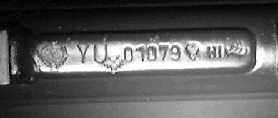 The gun was bears the HI date code (1978), but is
stamped as being an Enfield produced MP5 (EN). Normally only German produced MP5s
have the date coded in this way. Further inspection of the top of the receiver
reveals a German quality control stamp as well as an Ulm proof mark (stag's
antler). The serial number of the weapon is 01079 and is prefixed by a YU. After
further investigation, it would seem that this particular MP5 was part of a
batch produced by HK Germany for the Yugoslavian Police (YU). The gun is marked
EN (Enfield) because it was shipped through the UK to avoid German export
restrictions. Much is said about the difference in quality between HK, POF, MKE,
EN, EM, etc. produced MP5s. Whilst I am sure that HK-produced MP5s offer the
best quality, I don't really feel that it should make any difference to a deac
collector.
The gun was bears the HI date code (1978), but is
stamped as being an Enfield produced MP5 (EN). Normally only German produced MP5s
have the date coded in this way. Further inspection of the top of the receiver
reveals a German quality control stamp as well as an Ulm proof mark (stag's
antler). The serial number of the weapon is 01079 and is prefixed by a YU. After
further investigation, it would seem that this particular MP5 was part of a
batch produced by HK Germany for the Yugoslavian Police (YU). The gun is marked
EN (Enfield) because it was shipped through the UK to avoid German export
restrictions. Much is said about the difference in quality between HK, POF, MKE,
EN, EM, etc. produced MP5s. Whilst I am sure that HK-produced MP5s offer the
best quality, I don't really feel that it should make any difference to a deac
collector.
The weapon was originally the charcoal grey
colour found on 1970s MP5s. However, the original finish was not in the best
condition and I wanted the weapon to look like a 1980s+ model. Therefore, I
(very carefully) refinished it, using enamel paint and baking the finish after
application. I feel that it was successful - judge for yourself in the photos.
Of course, a weapon of this era should not have a
3 round burst trigger group. It should have an SEF group or more specifically a
UJR group if it is a Yugo model. The trigger group has of course been swapped. I
do stress swapped as it would of course be illegal for me to possess a component
part of a restricted weapon unless it was part of the whole. I therefore no
longer have the original SEF lower, but I'm quite happy just to have the 3 round burst
group!!! Although it may not be evident from the photos, the new trigger group
is in fact a POF (Pakistani Ordnance Factory) model.
You will notice from the photos that this weapon
has the fixed stock (A4) as well as the sliding stock (A5). It is also
displaying a Surefire 628 tactical forearm. Many of you will be aware that this
is a very popular accessory for the MP5, particularly for users involved in
tactical entry. If you have never seen one of these, you will be amazed at how
much light they produce as well as the continuity of the beam. HK now ship this
product as a standard item on some of their production MP5s. The 628 is
available in this country, but it isn't cheap (about £220) - alternatively an
US Internet sale will secure you one for a lot less. Whilst this is an expensive add-on,
it certainly looks the part. The Swiss firm Brugger and Thomet also produce a
version of the the tactical light forearm. This is a very well made piece of kit
with the added advantage that it has a constant on switch (as well as the touch
switch). Its light source and beam focus are not quite as good as the Surefire
model, but it does cost less (about £165).
Two photos are provided of the 3 round burst
trigger group. Whilst they don't show a great deal, you will appreciate the
complexity of the mechanism involved. In both photos, as well as the main
(larger) hammer spring, a smaller spring is visible. This is part of the
mechanism for the 3 round burst selection on the trigger group. I have not taken
my trigger group apart to examine the mechanism (nor do I intend to), but its
operation is effectively described by SoF magazine:
'They consist of an intricate ratchet-counting device fitted to the trigger mechanism, which holds the sear off the hammer until the allotted number of rounds
have been fired. The device ensures that only the correct number of rounds are fired in a single burst and any interruption commences a new count. After each burst the trigger must be released to set the counter back to zero.'
© SoF Magazine
Some MP5 users maintain that the 3 round burst
trigger group is a superfluous item on the MP5. The reasoning behind this is
that with its cyclic rate of 800 - 875 rpm, it is possible for experienced personnel
to fire short controlled bursts from an MP5 on full auto.
The MP5 is very much a weapon system. It has been
designed to accept a whole host of HK and aftermarket accessories (please see
the photo below). Of particular note are the:
- twin magazine clamp
- R3/3 sling
- various suppressors
The twin mag clamps are very popular with MP5
operators because they give access to 60 rounds straight off. I have also
actually seen pictures of three mags clamped together (using 2 clamps). Having
tried this, I would say that the weapon becomes quite unwieldy (and of course
heavier). The R3/3 sling is (in)famous and is a very effective piece of kit
(once you have worked out how to put it on). Lots of suppressor designs exist
for the MP5. One which I know is produced in this country, is the LIST design.
This looks quite a bit like a Mac 10 suppressor (two piece stepped design) and
uses a locking mechanism around the three barrel lugs to secure it to the gun.
Dummy ones can be obtained for about £70.
One of the photos below shows part of the newest
MP5 incarnation - the MP5F or MP5 French. This new version includes different
sling attachment points on both the rear stock assembly (shown) and the muzzle.
Some might say that with the advent of the UMP 45, time is running out for the
MP5 in its position as the weapon of choice for elite teams. This may be the
case, but due to the high cost of an MP5, I think they will be around for some
time yet - at least until they have been seen to give value for money.
This concludes the MP5 review. To finish, I leave
you with this quote from the HKPro website:
'The MP5 is that by which all other designs are
judged.'
Resources:
Heckler
and Koch USA
HKPro
Project 64: The MP5 submachine gun story - see
link on email page
 |
| MP5
A5 - showing detail of trigger group markings (click to view larger) |
| MP5
A5 - showing full gun with Surefire 628 tactical forearm (click to
view larger) |
|
 |
 |
| MP5
A4 - showing full gun with additional A5 stock (click to view
larger) |
| 4
position trigger mechanism with 3 round burst fire (click to view
larger) |
|
 |
 |
| MP5
A4 - showing detail of 628 forearm and with 30 rnd mag in place
(click to view larger) |
| 4
position trigger mechanism with 3 round burst fire (click to view
larger) |
|
 |
 |
| Some
of the accessories available for the MP5 series of weapons (click to
view larger) |
| Variations
in stock design on the relatively new MP5F (French) |
|
 |
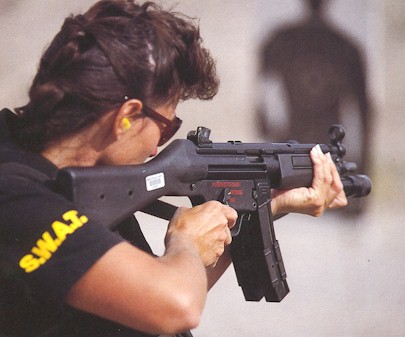
The
MP5 A4 in action
 The
MP5 began life in the early 1960's as the HK54 through a project known as
'Project 64'. This early gun had a flip-type rear sight positioned forward over the magazine well. The barrel had cooling ribs and two lateral slots cut over the muzzle to serve as a compensator. The forearm had cooling slots cut into it,
the bolt carrier was longer and heavier than current models and the ejection
port smaller. Even at the early stage, the familiar SEF trigger group was an
integral part of the design. See picture right and below.
The
MP5 began life in the early 1960's as the HK54 through a project known as
'Project 64'. This early gun had a flip-type rear sight positioned forward over the magazine well. The barrel had cooling ribs and two lateral slots cut over the muzzle to serve as a compensator. The forearm had cooling slots cut into it,
the bolt carrier was longer and heavier than current models and the ejection
port smaller. Even at the early stage, the familiar SEF trigger group was an
integral part of the design. See picture right and below.

 The gun was bears the HI date code (1978), but is
stamped as being an Enfield produced MP5 (EN). Normally only German produced MP5s
have the date coded in this way. Further inspection of the top of the receiver
reveals a German quality control stamp as well as an Ulm proof mark (stag's
antler). The serial number of the weapon is 01079 and is prefixed by a YU. After
further investigation, it would seem that this particular MP5 was part of a
batch produced by HK Germany for the Yugoslavian Police (YU). The gun is marked
EN (Enfield) because it was shipped through the UK to avoid German export
restrictions. Much is said about the difference in quality between HK, POF, MKE,
EN, EM, etc. produced MP5s. Whilst I am sure that HK-produced MP5s offer the
best quality, I don't really feel that it should make any difference to a deac
collector.
The gun was bears the HI date code (1978), but is
stamped as being an Enfield produced MP5 (EN). Normally only German produced MP5s
have the date coded in this way. Further inspection of the top of the receiver
reveals a German quality control stamp as well as an Ulm proof mark (stag's
antler). The serial number of the weapon is 01079 and is prefixed by a YU. After
further investigation, it would seem that this particular MP5 was part of a
batch produced by HK Germany for the Yugoslavian Police (YU). The gun is marked
EN (Enfield) because it was shipped through the UK to avoid German export
restrictions. Much is said about the difference in quality between HK, POF, MKE,
EN, EM, etc. produced MP5s. Whilst I am sure that HK-produced MP5s offer the
best quality, I don't really feel that it should make any difference to a deac
collector.





